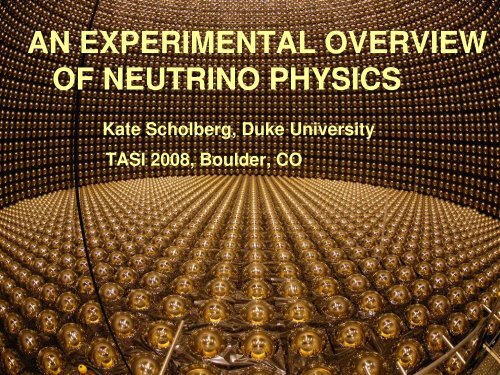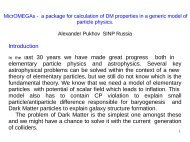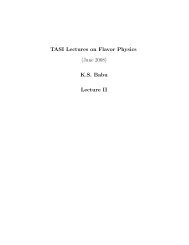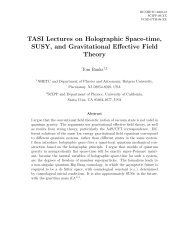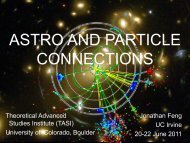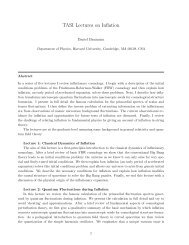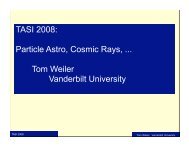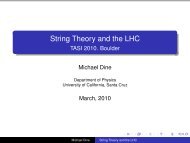an experimental overview of neutrino physics - University of ...
an experimental overview of neutrino physics - University of ...
an experimental overview of neutrino physics - University of ...
You also want an ePaper? Increase the reach of your titles
YUMPU automatically turns print PDFs into web optimized ePapers that Google loves.
AN EXPERIMENTAL OVERVIEWOF NEUTRINO PHYSICSKate Scholberg, Duke <strong>University</strong>TASI 2008, Boulder, CO
Alexei Smirnov, Neutrino 2008, Christchurch NZ
These lectures:experimentHow do we know what we know?What's within reach for the future?
OUTLINELecture 1: Oscillation experiments ILecture 2: Oscillation experiments IILecture 3: Nonoscillation experiments
Lecture 1Overview <strong>of</strong> <strong>neutrino</strong> sources, detectionNeutrino mass <strong>an</strong>d oscillationsCurrent status <strong>of</strong> oscillation <strong>physics</strong>, part I:Atmospheric parameter spaceSuperK atmospheric <strong>neutrino</strong>sK2K beamMINOS beamCNGS beam
NEUTRINOS~3 ~1200 174,000 MeV/c 2QuarksuctdsbLeptons~6 ~100 ~4200 MeV/c 20.511 105.6 1778 MeV/c 2eµτν ν νe µ τ●Spin 1/2●Zero charge●3 flavors (families)●Interact only via weak interaction●Tiny mass (< 1 eV)In the St<strong>an</strong>dardModel <strong>of</strong> particle<strong>physics</strong>, neutralpartners to thecharged leptons
Why Do Neutrinos Matter?They are a piece <strong>of</strong> the puzzle: we must underst<strong>an</strong>d theirproperties if we are to underst<strong>an</strong>d fundamental particles <strong>an</strong>dtheir interactions, as well as gain insight into cosmologyWhat are the masses <strong>an</strong>d mixings? Do <strong>neutrino</strong>s violate CP?What is the absolute mass scale?Are <strong>neutrino</strong>s their own <strong>an</strong>tiparticles? Do <strong>neutrino</strong>s haveproperties pointing the way beyond the SM?What astrophysical information c<strong>an</strong> welearn from <strong>neutrino</strong>s?
The Big B<strong>an</strong>gSources <strong>of</strong> wild <strong>neutrino</strong>sThe Atmosphere(cosmic rays)SupernovaeAGN's, GRB'smeV eV keV MeV GeV TeV PeV EeVRadioactivedecay in theEarthThe SunJ. Becker,arXiv:0810.1557
Sources <strong>of</strong> 'tame' <strong>neutrino</strong>sNuclearreactorsProton acceleratorsBeta beamseV keV MeV GeV TeVArtificialradioactivesourcesStoppedpionsourcesMuonstorageringsUsually (but not always) better understood
Neutrino Interactions with MatterCharged Current (CC) Neutral Current (NC)d ud dW +ν ll Z 0ν l+ N → l ± + N'Produces leptonwith flavor correspondingto <strong>neutrino</strong> flavor(must have enough energyto make lepton)ν xν xFlavorblindDetect energy loss <strong>of</strong> final state charged particle
Neutrino detectors: in general w<strong>an</strong>t to knowCC or NC?What flavor?What energy?Features that matter energy resolution<strong>an</strong>d threshold flavor/mode tagging statistics (lots <strong>of</strong> target massor <strong>neutrino</strong>s or both) low background: typicallyunderground to hide fromcosmic rays
AssumeNeutrino Mass <strong>an</strong>d OscillationsHow c<strong>an</strong> we learn about <strong>neutrino</strong> mass?FLAVOR STATES| ν f>weaklyinteractingaresuperpositions<strong>of</strong>MASS STATES| ν m>N| f>=∑i=1U fi| i>unitary mixing matrixIf mixing matrix isnot diagonal,get flavor oscillationsas <strong>neutrino</strong>s propagate(essentially, interference between mass states)
Simple twoflavor case| f>= cos| 1>sin| 2>| g>=−sin| 1>cos| 2>Propagate a dist<strong>an</strong>ce L:| i( t )>=e −iE t i| i( 0 )>~e −im 2 L/2pi|i ( 0 )>Probability <strong>of</strong> detecting flavor g at L:P( f g)=sin 2 2sin 2 1.27m2 LEE in GeVL in km∆m 2 in eV 2Parameters <strong>of</strong> nature to measure: θ, ∆m 2 =m 12m 22
P( f g)=sin 2 2sin 2 1.27 m2 LE∆m 2 =m 12m 22If flavor oscillations are observed,then there must be at least onenonzero mass state* Note: oscillation depends on mass differences,not absolute masses
Probability<strong>of</strong> ch<strong>an</strong>gingflavorP( f f)P ( f g)=sin 2 2sin 2 1.27 m2 LEWavelength=πE/(1.27∆m 2 )P( f g)Amplitude∝ sin 2 2θDist<strong>an</strong>ce traveled∆m 2 , sin 2 2θ are the parameters <strong>of</strong> nature;L, E depend on the <strong>experimental</strong> setup
The Experimental Game●Start with some <strong>neutrino</strong>s (natural or artificial)●Measure (or calculate) flavor composition<strong>an</strong>d energy spectrum●Let them propagate●Measure flavor <strong>an</strong>d energies againHave the flavors <strong>an</strong>d energies ch<strong>an</strong>ged?If so, does thech<strong>an</strong>ge followP ( f g)=sin 2 2sin 2 1.27 m2 LDisappear<strong>an</strong>ce: ν's oscillate into 'invisible' flavore.g. ν e→ ν µat ~MeV energiesAppear<strong>an</strong>ce: directly see new flavore.g. ν µ→ ν τat ~GeV energiesE?
Experimental statisticsOscillationParameterSpaceTwiddleL/EFrequency∝ ∆m 2 L/Efastwiggle2 P ( f g)=sin 2 2sin 1.27 Lm2 Eallowed regionslowwiggleAmplitude∝ sin 2 2θ
More generally, for 3 flavors: e e1U e2U e3 1 U 1U 2U 3 2 U =U 1U 2U 3 3MakiNakagawaSakata (MNS)matrixP( f g)= fg−4∑ji±2∑ji2 Re(U fiU giU * fjU * gj)sin 1.27m 2ijEIm(U fiU giU * fjU * gj)sin 2.54 m 2ijEFrequently, c<strong>an</strong> use 2flavor approximatione.g. if ∆m ij 2 >> ∆m jk2LLNote:3 flavors ⇒ 2 independent ∆m ij2
The Three SignalsSOLAR NEUTRINOS e xElectron <strong>neutrino</strong>s from the Sun aredisappearingDist<strong>an</strong>ce ~ 10 8 km, Energy ~ 0.115 MeVATMOSPHERIC NEUTRINOS xMuon <strong>neutrino</strong>s created in cosmic ray showersare disappearing on their way through the EarthDist<strong>an</strong>ce ~ 1013000 km, Energy ~ 0.1100 GeVACCELERATOR NEUTRINOSElectron <strong>an</strong>ti<strong>neutrino</strong>s appearing in a beam<strong>of</strong> muon <strong>an</strong>ti<strong>neutrino</strong>s at LSNDDist<strong>an</strong>ce ~ 30 m, Energy ~ 3050 MeV e
The Three Signals in Parameter SpaceLSND eAtmosphericν's xSolar(<strong>an</strong>dreactor)ν's e x(Note: c<strong>an</strong> have only 2 independent ∆m 2 , for 3 <strong>neutrino</strong>s)
First, zoom in to atmospheric ν parameter space x
Atmospheric Neutrinoscosmic ray (p)E~ 0.1100 GeVL~1013000 kmπ + µ + e +ν µν µν eAbsolute flux knownto ~15%, but flavor ratioknown to ~5%By geometry, expect flux withupdown symmetry above ~1 GeV(no geomagnetic effects)
Detecting Neutrinos with Cherenkov LightCharged particles produced in <strong>neutrino</strong>interactions emit Cherenkov radiation if β>1/nThresholds (MeV)mE th=e 0.731−1/n 2 1/2µ 150π 200p 1350Angle: cos C= 1θ C= 42 0No. <strong>of</strong> photons ∝ energy lossnfor relativisticparticle in water
Water Cherenkov ν DetectorsPhotons → photoelectrons→ amplified PMT pulses→ digitize charge, time→ reconstruct energy,direction, vertex
SuperKamiok<strong>an</strong>deOuterdetector:1889outwardlookingPMTsWater Cherenkov detectorin Mozumi, Jap<strong>an</strong>32 kton <strong>of</strong>ultrapure waterInner detector:11,146inwardlookingPMTs1 km underground to keep away from cosmic rays
Event display <strong>of</strong> ahigh energy <strong>neutrino</strong>interaction in SK("snapshot <strong>of</strong> a ν")
SuperK Accident November 12, 20012/3 <strong>of</strong> PMTsdestroyedin chain reactionimplosion
Now haveacrylic/fiberglassshellsfor shockprotectionBack online in 2003 with 47% <strong>of</strong> ID PMTs, full OD (SK II)Full reconstruction over winter '05'06 (SK III)Electronics/DAQ/<strong>of</strong>fline upgrade this year (SK IV)
SuperK Full Reconstruction Photo Gallery
Atmospheric ν's Experimental Strategy:High energy interactions <strong>of</strong> ν's with nucleonsd uW +ν l l ν e+ n → e − + pν e+ p → e + + nν µ+ n → µ − + pν µ+ p → µ + + nTag neutrin<strong>of</strong>lavorby flavor <strong>of</strong>outgoingleptonν l+ N → l ± + N'CC quasielastic ("single ring"): cle<strong>an</strong>est sample
Get differentpatternsin Cherenkovlight fore <strong>an</strong>d µ(sim. for otherdetector types)From Cherenkov cone get <strong>an</strong>gle, infer pathlength
Deficit interpreted as twoflavor oscillationSK I+II, preliminaryDisappear<strong>an</strong>ceconsistentwith ν µ→ν τ
Getting more from the data set:parent ν energies for subsamplesFullycontainedsingle ring multi ringelikeµlikePartiallycontainedUpwardgoing muonsstopping throughgoing
SK I+II <strong>an</strong>alysis:Excellent fit tooscillation hypothesis!
What flavors are involved in thisν µ→ ν xdisappear<strong>an</strong>ce?Expect about 80 τ's in sample;hard to distinguish from multiπ events●Pure ν µ→ ν e?No upgoingelike excesselikeupgoingdowngoing
What flavors are involved in thisν µ→ ν xdisappear<strong>an</strong>ce?Expect about 80 τ's in sample;hard to distinguish from multiπ events●NOT pure ν µ→ ν e: no upgoing elike excess(some admixture in 3flavor scenario allowed)●Could it be ν µ→ ν sterile?
For ν µ→ ν sterilewould expect:Upgoing NC deficit:●ν τ's have NC interactions●ν sterile's "really" disappearAngular distortion at high energy (>~ 5 GeV):qν τZ 0qν τvs.qν sqν s"mattereffects"in theEarthaffectoscillationprobability
SuperK data: select NC multiring<strong>an</strong>d highenergy eventsSK I dataSK, PRL 85(2000) 39994003ν µ→ ν τν µ→ ν sterilemultiringPCupmuNC events:no upgoingHigh energy events:(partially contained<strong>an</strong>d upgoing muons)deficit no <strong>an</strong>gular distortionCurrent preliminary SK I+II ν µ→ ν sterileexclusion: 7.3
What flavors are involved in thisν µ→ ν xdisappear<strong>an</strong>ce?Expect about 80 τ's in sample;hard to distinguish from multiπ events●NOT pure ν µ→ ν e: no upgoing elike excess(some admixture in 3flavor scenario allowed)●NOT pure ν → µν sterile: would expect* upgoing NC deficit* <strong>an</strong>gular distortion <strong>of</strong> high E events} notseen
What flavors are involved in thisν µ→ ν xdisappear<strong>an</strong>ce?Expect about 80 τ's in SK I sample;hard to distinguish from multiπ events●NOT pure ν µ→ ν e: no upgoing elike excess(some admixture in 3flavor scenario allowed)●NOT pure ν → µν sterile: would expect* upgoing NC deficit} not* <strong>an</strong>gular distortion <strong>of</strong> high E events seen●C<strong>an</strong> we check ν µ→ ν τdirectly ?
Tau Appear<strong>an</strong>cein SuperKTypical MC τ event Energy Threshold:3.5 GeVe or or hadronsHadronsExpect about 80 τ'sin SK I sample... but they arehard to distinguishfrom other multiringν interaction events
Select τlike events: (energy, shape, rings, decay electrons)2 <strong>an</strong>alyses (likelihood <strong>an</strong>d neural network)yield consistent <strong>an</strong>swersSK, PRL 97(2006) 171801MC expectation:78.4±27 τ'sNeural Network(39% efficiency)From fit toτlike sample:(shaded)16.0134±48 stat ± 27.2τ'sConsistent with (expected) slight excess <strong>of</strong> upgoing τ's
What flavors are involved in thisν µ→ ν xdisappear<strong>an</strong>ce?Expect about 80 τ's in sample;hard to distinguish from multiπ events●NOT pure ν µ→ ν e: no upgoing elike excess(some admixture in 3flavor scenario allowed)●NOT pure ν → µν sterile: would expect* upgoing NC excess* <strong>an</strong>gular distortion <strong>of</strong> high E events●CONSISTENT WITH ν µ→ ν τ:~2.4σ excess <strong>of</strong> upgoing "τlike" events} notseen
Resolving the "wiggle" with SK atm ν'sP( f g)=sin 2 2sin 2 1.27m2 LEFC/PC eventsPoor resolution in L/E (~10's <strong>of</strong> %) washes it out⇒ hard to distinguish oscillationfrom exotic kinds <strong>of</strong> disappear<strong>an</strong>ce
Select events for which resolution in L/E is good: (
Similar plot with this selected subset:Decoherence ruled out at 5.0Decay ruled out at 4.1"the dip"Seems tobe reallywiggling!
Improves ∆m 2 resolution a littleOscillation fit w/highresolution L/E data sampleSt<strong>an</strong>dard <strong>an</strong>alysis
Next: INDEPENDENT TEST <strong>of</strong>atmospheric <strong>neutrino</strong> oscillationsusing a wellunderstood ν beamE ν~ GeV, L~ 100's <strong>of</strong> km for same L/E2LP( f g)=sin 2 2sin 1.27m2 ELONG BASELINE EXPERIMENTSCompare flux, flavor <strong>an</strong>denergy spectrum atnear <strong>an</strong>d far detectors
K2K (KEK to Kamioka)Long BaselineExperiment~ 1 GeV muon <strong>neutrino</strong>s12 GeV protons on Al target+ π focusing horn+ decay pipe for pionsEvents matched w/GPS
The Neutrino Beamline at KEK
The Near Detector (300 m away)(scibar)Characterize the ν beam for extrapolation to SK
Results from K2K: full data sampleSingleringµlikeeventsTotal 112beam eventsobserved;expect 158±9Suppression observed,spectral distortionconsistent withoscillations2 P ( f g)=sin 2 2sin 1.27 Lm2 E
K2K Allowed Oscillation ParametersConsistentwith SKatmosphericν's !SK INooscillationexcluded at>4σ
Current state<strong>of</strong> the art forlong baselinedisappear<strong>an</strong>ceoscillation:MINOS(Main InjectorNeutrino OscillationSearch)Fermilab to Minnesota,735 km baselinemuon <strong>neutrino</strong> beam
NuMI Beamline at FermilabH. Gallagher, Nu200893% muon <strong>neutrino</strong>in low energy mode
MINOS Detectors:near <strong>an</strong>d fariron plates+ pl<strong>an</strong>es <strong>of</strong>scintillating fibersw/ magnetic fieldMagnetic fieldallows <strong>neutrino</strong> vs<strong>an</strong>ti<strong>neutrino</strong> selectionν µ+ n → µ − + pν µ+ p → µ + + n
Event flavors selected based on topology
Results <strong>of</strong> MINOS muon <strong>neutrino</strong> disappear<strong>an</strong>ce <strong>an</strong>alysisH. Gallagher, Nu2008SpectraldistortionobservedP( f g)=sin 2 2 sin 2 1.27 m2 LE
Allowed oscillation parameters from MINOSTightestresolutionin m 2
CNGS: CERN Neutrinos to Gr<strong>an</strong> Sasso~20 GeV ν µbeam, 732 km baseline
The CNGS beamlineDesignedto searchfor appear<strong>an</strong>ceneed highenergy beam tomakethemG. Rosa, Nu2008
Detectors at LNGS are optimizedfor τ appear<strong>an</strong>cefinegrain imaging detectors tos earch explicitly for τ decaysOPERA, ICARUS
OPERAlead/emulsion s<strong>an</strong>dwich +active scintillator strip pl<strong>an</strong>es +magnetic spectrometerExtract bricks forsc<strong>an</strong>ning ifelectronic detectorindicates τlike event1.35 kton target mass(~90% complete)
First long dist<strong>an</strong>ce data in 2007G. Rosa, Nu200838 intarget(nontau)events
Expectations for 5 years <strong>of</strong> OPERA runningG. Rosa, Nu2008totalexpectedsignal in targettotalexpectedbackground
ICARUSLiquid Argon Time ProjectionChamberElectronic finegrain imaging"Digital BubbleChamber"Drift ionizationcharge: space collection<strong>of</strong> charge givesx,y coordinate drift time givesz coordinate
600 ton detector at LNGS awaiting fill
Summary <strong>of</strong> atmospheric ν parameter space SuperK has cle<strong>an</strong>,high statistics atmospheric disappear<strong>an</strong>ce signal;good evidence it's K2K confirmed the oscillationhypothesis with disappear<strong>an</strong>ce<strong>of</strong> beam <strong>neutrino</strong>s MINOS now has highestprecision m 2 measurement Soon: CNGS experimentsto explicitly see appear<strong>an</strong>ce
Lecture 2Current status <strong>of</strong> oscillation <strong>physics</strong>, part II:Solar <strong>neutrino</strong> experimentsReactor <strong>neutrino</strong> experimentsShort baseline experimentsWhat's next for oscillation <strong>physics</strong>Long baseline experimentsReactor experiments


